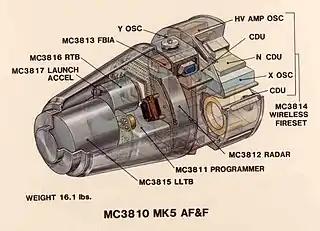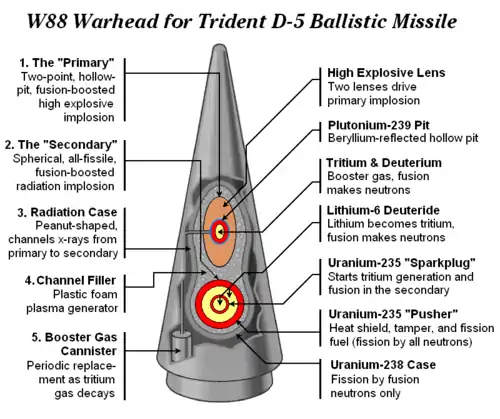W88
The W88 is an American thermonuclear warhead, with an estimated yield of 475 kilotonnes of TNT (1,990 TJ),[2] and is small enough to fit on MIRVed missiles. The W88 was designed at the Los Alamos National Laboratory in the 1970s. In 1999, the director of Los Alamos who had presided over its design described it as "the most advanced U.S. nuclear warhead".[4] As of 2021, the latest version is called the W88 ALT 370,[5] the first unit of which came into production on 1 July, 2021, after 11 years of development.[6] The Trident II submarine-launched ballistic missile (SLBM) can be armed with up to eight W88 warheads (Mark 5 re-entry vehicle) or twelve 100 kt W76 warheads (Mark 4 re-entry vehicle), but it is limited to eight warheads under the Strategic Offensive Reductions Treaty.
| W88 | |
|---|---|
 Diagram of the W88 warhead: In 1999, information was released showing that in the W88, the primary (top) is egg-shaped, while the secondary (bottom) is spherical. | |
| Type | Nuclear weapon |
| Service history | |
| In service | 1989 to present |
| Used by | United States Navy |
| Production history | |
| Designer | Los Alamos National Laboratory |
| Designed | 1970s to 1980s |
| Manufacturer | Rocky Flats |
| Produced | 1988 to 1989 (full production) |
| No. built | ~400 |
| Specifications | |
| Mass | 175-360 kg[1][2] |
| Length | Approximately 60 inches (150 cm)[3] |
| Diameter | 18 inches (46 cm)[3] |
Detonation mechanism | Contact, airburst |
| Blast yield | 475 kilotonnes of TNT (1,990 TJ) |

History
Much of the work was done on the warhead by Los Alamos National Laboratory before the introduction of the Threshold Test Ban Treaty in 1976. A production run of 4000 to 5000 warheads was initially envisioned but production was halted after the November 1989 raid on the Rocky Flats Plant by the FBI. Consideration was given to restarting production but the program was terminated in January 1992. Final production was approximately 400 warheads.[7]
Design revelations
Information about the W88 has implied that it is a variation of the standard Teller–Ulam design for thermonuclear weapons. In a thermonuclear weapon such as the W88, nuclear fission in the primary stage causes nuclear fusion in the secondary stage, which results in the main explosion. Although the weapon employs fusion in the secondary, most of the explosive yield comes from fission of nuclear material in the primary, secondary, and casing.[8]
In 1999, the San Jose Mercury News reported that the W88 had an egg-shaped primary and a spherical secondary, which were together inside a radiation case known as the "peanut" for its shape.[Note 1] Four months later, The New York Times reported that in 1995 a supposed double agent from the People's Republic of China delivered information indicating that China knew these details about the W88 warhead as well, supposedly through espionage (this line of investigation eventually resulted in the abortive trial of Wen Ho Lee). If these stories are true, it would indicate a variation of the Teller-Ulam design which would allow for the miniaturization required for small MIRVed warheads.[10][11][12]
The value of an egg-shaped primary lies apparently in the fact that a MIRV warhead is limited by the diameter of the primary—if an egg-shaped primary can be made to work properly, then the MIRV warhead can be made considerably smaller yet still deliver a high-yield explosion—a W88 warhead manages to yield up to 475 kt with a reentry vehicle length of approximately 60 inches (1,500 mm) and base diameter of 18 inches (460 mm) while the actual physics package is 35 inches (890 mm) long.[3] By different estimates the warhead has been given weights of 175 kilograms (386 lb),[1] 400 pounds (180 kg),[3] and 360 kilograms (790 lb).[2] The smaller warhead allows more of them to fit onto a single missile and improves basic flight properties such as speed and range.
The calculations for a nonspherical primary are apparently orders of magnitude more difficult than for a spherical primary. A spherically symmetric simulation is one-dimensional, while an axially symmetric simulation is two dimensional. Simulations typically divide up each dimension into discrete segments, so a one-dimensional simulation might involve only 100 points, while a similarly accurate two dimensional simulation would require 10,000. This would likely be the reason they would be desirable for a country like the People's Republic of China, which already developed its own nuclear and thermonuclear weapons, especially since they were no longer conducting nuclear testing which would provide valuable design information.[13]

The weapon contains the material Fogbank.[14] While its precise nature is classified, Fogbank is believed to be a foam or aerogel material used in the weapon's interstage.[15]
Explanatory notes
- The code-name of the primary was Komodo and that of the secondary was Cursa, which come from the names of a ferocious lizard, the Komodo dragon, and a bright star, Cursa.[9]
References
- Harvey, John R.; Michalowski, Stefan (21 December 2007). "Nuclear weapons safety: The case of trident". Science & Global Security. 4 (1): 288. doi:10.1080/08929889408426405.
- "The W88 Warhead".
- Hansen, Chuck (2007). Swords of Armageddon – Volume VI. Chukelea Publications. p. 475. ISBN 978-0-9791915-6-5.
- Harold M. Agnew (17 May 1999), "Letter: Looking for Spies in Nuclear Kitchen" Archived 2016-03-04 at the Wayback Machine, The Wall Street Journal, p. A27.
- "W88 warhead program performs successful tests". Sandia Labs News Releases (Press release). Sandia Corporation. October 28, 2014. Archived from the original on November 20, 2016. Retrieved November 19, 2016.
- "First Improved W88 Nuclear Warhead for Navy's Trident Missiles Rolls Off the Assembly Line". thedrive.com. 13 July 2021. Archived from the original on 14 July 2021. Retrieved 14 July 2021.
- Sublette, Carey. "The W88 Warhead". Retrieved 7 September 2018.
- Stober & Hoffman 2001, pp. 41–42
- Stober & Hoffman 2001, p. 41
- Stober, Dan; Hoffman, Ian (2001). A Convenient Spy: Wen Ho Lee and the Politics of Nuclear Espionage. Simon and Schuster. ISBN 978-0-7432-2378-2. Archived from the original on 2017-03-24. Retrieved 2016-12-21.
- Howard Morland, "The holocaust bomb: A question of time Archived 2019-06-27 at the Wayback Machine" (February 2003)
- Broad, William J. (September 7, 1999). "Spies vs. Sweat: The Debate Over China's Nuclear Advance". The New York Times. Archived from the original on September 18, 2017. Retrieved December 16, 2016.
- Christopher Cox, chairman, Report of the United States House of Representatives Select Committee on U.S. National Security and Military/Commercial Concerns with the People's Republic of China (1999), esp. Ch. 2, "PRC Theft of U.S. Thermonuclear Warhead Design Information". Archived 2005-08-04 at the Wayback Machine
- Robert B Bonner; Stephan E Lott; Howard H Woo (January 2001). Secondary Lifetime Assessment Study (PDF) (Report). Sandia National Labs. p. 52. SAND2001-0063. Archived (PDF) from the original on 2021-11-06.
- Last, Jonathan V. (18 May 2009). "The Fog of War: Forgetting what we once knew". The Weekly Standard. 14 (33). Archived from the original on 8 June 2019. Retrieved 8 February 2022.
External links
- W88 at the Nuclear Weapons Archive
- W88 at GlobalSecurity.org
- "Department of Energy, FBI, and Department of Justice Handling of the Espionage Investigation into the Compromise of Design Information on the W-88 Warhead"—Statement by U.S. Senate Governmental Affairs Committee heads.
- PRC theft of U.S. thermonuclear warhead design information
- Report on the Government's Handling of the Investigation and Prosecution of Dr. Wen Ho Lee